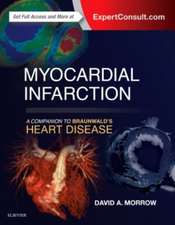Cardiac Arrhythmias: New Therapeutic Drugs and Devices: Proceedings of the Symposium on New Drugs and Devices, held at Philadelphia, PA October 4 and 5, 1984: Developments in Cardiovascular Medicine, cartea 47
Editat de J. Morganroth, E. Neil Mooreen Limba Engleză Hardback – 30 apr 1985
| Toate formatele și edițiile | Preț | Express |
|---|---|---|
| Paperback (1) | 1098.48 lei 6-8 săpt. | |
| Springer Us – 2 oct 2011 | 1098.48 lei 6-8 săpt. | |
| Hardback (1) | 1105.40 lei 6-8 săpt. | |
| Springer Us – 30 apr 1985 | 1105.40 lei 6-8 săpt. |
Din seria Developments in Cardiovascular Medicine
- 5%
 Preț: 1484.50 lei
Preț: 1484.50 lei - 5%
 Preț: 375.17 lei
Preț: 375.17 lei - 5%
 Preț: 354.10 lei
Preț: 354.10 lei - 5%
 Preț: 1419.03 lei
Preț: 1419.03 lei - 5%
 Preț: 376.43 lei
Preț: 376.43 lei - 5%
 Preț: 1098.27 lei
Preț: 1098.27 lei - 5%
 Preț: 1438.38 lei
Preț: 1438.38 lei - 5%
 Preț: 376.78 lei
Preț: 376.78 lei - 5%
 Preț: 368.37 lei
Preț: 368.37 lei - 5%
 Preț: 380.25 lei
Preț: 380.25 lei - 5%
 Preț: 2117.58 lei
Preț: 2117.58 lei - 5%
 Preț: 367.28 lei
Preț: 367.28 lei - 5%
 Preț: 366.56 lei
Preț: 366.56 lei - 5%
 Preț: 371.10 lei
Preț: 371.10 lei - 5%
 Preț: 370.94 lei
Preț: 370.94 lei - 5%
 Preț: 783.18 lei
Preț: 783.18 lei - 5%
 Preț: 713.18 lei
Preț: 713.18 lei - 5%
 Preț: 1098.27 lei
Preț: 1098.27 lei - 5%
 Preț: 375.49 lei
Preț: 375.49 lei - 5%
 Preț: 373.47 lei
Preț: 373.47 lei - 5%
 Preț: 723.93 lei
Preț: 723.93 lei - 5%
 Preț: 1104.13 lei
Preț: 1104.13 lei - 5%
 Preț: 2117.20 lei
Preț: 2117.20 lei - 5%
 Preț: 716.09 lei
Preț: 716.09 lei - 5%
 Preț: 372.03 lei
Preț: 372.03 lei - 5%
 Preț: 722.33 lei
Preț: 722.33 lei - 5%
 Preț: 660.07 lei
Preț: 660.07 lei - 5%
 Preț: 375.34 lei
Preț: 375.34 lei - 5%
 Preț: 1423.22 lei
Preț: 1423.22 lei - 5%
 Preț: 715.35 lei
Preț: 715.35 lei - 5%
 Preț: 790.69 lei
Preț: 790.69 lei - 5%
 Preț: 720.68 lei
Preț: 720.68 lei - 5%
 Preț: 3185.49 lei
Preț: 3185.49 lei - 5%
 Preț: 1418.27 lei
Preț: 1418.27 lei - 5%
 Preț: 784.64 lei
Preț: 784.64 lei - 5%
 Preț: 714.63 lei
Preț: 714.63 lei - 5%
 Preț: 370.74 lei
Preț: 370.74 lei - 5%
 Preț: 376.22 lei
Preț: 376.22 lei - 5%
 Preț: 660.85 lei
Preț: 660.85 lei - 5%
 Preț: 368.37 lei
Preț: 368.37 lei
Preț: 1105.40 lei
Preț vechi: 1163.58 lei
-5% Nou
Puncte Express: 1658
Preț estimativ în valută:
211.51€ • 220.84$ • 175.06£
211.51€ • 220.84$ • 175.06£
Carte tipărită la comandă
Livrare economică 05-19 aprilie
Preluare comenzi: 021 569.72.76
Specificații
ISBN-13: 9780898387162
ISBN-10: 0898387167
Pagini: 356
Ilustrații: XII, 356 p.
Dimensiuni: 155 x 235 x 22 mm
Greutate: 0.69 kg
Ediția:1985
Editura: Springer Us
Colecția Springer
Seria Developments in Cardiovascular Medicine
Locul publicării:New York, NY, United States
ISBN-10: 0898387167
Pagini: 356
Ilustrații: XII, 356 p.
Dimensiuni: 155 x 235 x 22 mm
Greutate: 0.69 kg
Ediția:1985
Editura: Springer Us
Colecția Springer
Seria Developments in Cardiovascular Medicine
Locul publicării:New York, NY, United States
Public țintă
ResearchCuprins
I Basic Considerations.- 1 What animal models are useful in selecting new antiarrhythmic drugs?.- 2 How to test for antiarrhythmic drugs.- 3 Initial evaluation of new antiarrhythmic agents in man: normal volunteers or patients?.- 4 Is there a rational basis for the modified classification of antiarrhythmic drugs?.- Panel Discussion: Basic considerations.- II Status of Specific Antiarrhythmic Agents.- 5 Procainamide, Quinidine, Disopyramide, Cibenzoline, Pirmenol — efficacy in the treatment of ventricular arrhythmias: current status and controversies.- 6 Mexiletine, Tocainide and Ethmozine: newer class I antiarrhythmic agents.- 7 Class IC antiarrhythmic agents: status — 1984.- 8 Role of beta-blocking agents in the treatment of ventricular arrhythmias.- 9 Status of class III antiarrhythmic drugs: Amiodarone, Bretylium and Sotalol.- Panel Discussion: Status of specific antiarrhythmic agents.- III Special Considerations and FDA Standards.- 10 Some thoughts on efficacy trials of antiarrhythmic agents: pitfalls of mimicking clinical practice.- 11 Use of a computer in the new drug evaluation process.- 12 Sudden cardiac death — failure or effect of antiarrhythmic drug therapy?.- 13 Sudden death as an end-point for the clinical evaluation of antiarrhythmic drugs.- 14 Holter/exercise and electrophysiologic methods forevaluating drug therapy for malignant ventricular arrhythmias: do we need both models?.- Panel Discussion: Special considerations and FDA standards.- IV New Antiarrhythmic Devices.- 15 DVI vs DDD pacemakers - proarrhythmic or antiarrhythmic?.- 16 Pacing for ventricular tachycardia.- 17 Termination of ventricular tachycardia by transvenous cardioversion.- 18 The automatic implantable cardioverter/defibrillator.- 19 New antiarrhythmia devices — FDA’srequirements for effectiveness.- Panel Discussion: New antiarrhythmic devices.- V Evaluation Of Atrial Arrhythmias.- 20 Study designs to evaluate atrial arrhythmias are easy.- 21 Role of the autonomic nervous system in the generation of supraventricular tachyarrhythmias: clues to drug selection.- 22 Approaches to drug selection and serial drug testing.- Panel Discussion: Evaluation of atrial arrhythmias.- Participants.






